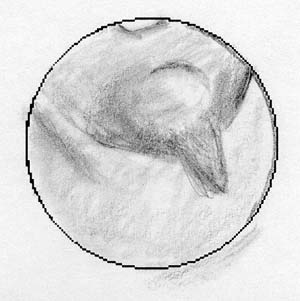
Sketched September 13 11:30 p.m. pacific DST (daylight savings time) 06:30 UT September 14 from my back deck. Seeing very good to excellent, transparency LM 5.0. 73 degrees at midnight. 100 degrees at 4:00 p.m. this afternoon.
| Date: 09/14/03 Lat 37N, Long 122W, elev. 200 feet | Sketch Time (UT): 6:30, (local time): 11:30 DST |
| Central Meridian: 273° | Filters: none |
| Instrument: 10-inch f/7.3 homemade Dobsonian reflector. | Distance from earth 0.40 AU, 60m km, 37m miles |
| Magnification: (12mm) 154x and (6mm) 309x Vixen Lanthanum eyepieces for this sketch | Transp. 4/6, Seeing 9/10, Antoniadi (I-V): II |
| Apparent Size: 23.67" | Magnitude: -2.6 |
Details about Mars: Diameter 23.67 arc seconds (Jupiter is about 30 -50 arc seconds in diameter depending on its distance from earth). Central Meridian 273 - the imaginary line passing through the planetary poles of rotation and bisecting the planetary disk, and is used to determine the longitude during an observing session.
The terminator, where daylight ends and evening begins on Mars is back! The terminator is now on the right and the planet is rotating left to right. In my sketches, the planet rotates Martian east to Martian west to match most other images and sketches. The features rotate from left to right, but due to a stroboscopic effect - earth and Mars' rotations are different by less than an hour each day so it actually seems like the features are rotating in the opposite direction. It is just like if a tire wheel is rotating just a little slower than the frame rate in which you are taking a picture and it appears to rotate backwards because the wheel will not quite be making a full rotation for each snap shot. So if you look at Mars at exactly the same time each night, it will appear to rotate backwards. Anyway, now the terminator is on the other side of the disk as we have passed opposition and Mars' phase is 99%. See August 9th sketch for a view of the planet at the same central meridian, same brightness, and same distance from earth, but before opposition!
Syrtis Major is the prominent angular feature pointing (down) toward the north pole of the planet. To the left (east) is a lighter area called Syria. Between Syrtis Major and the shrinking south polar cap (south is up in all my sketches) is the large oval impact crater basin called Hellas. Tonight I see part of Hellas lighter than last night, when it was a uniform color. Sinus Sabaeus is rotating on, and Mare Serpentis, another darker area flanks Hellas and the terminator. Sinus Meridiani is not visible yet, at the time of the sketch. Rotating off on the other side is Mare Cimmerium. And on the north polar area is a hazy cloud over the area - the north polar hood.

White Oaks Home | Sketches Index | Mars 2003 Index | Back | Next